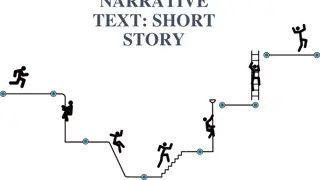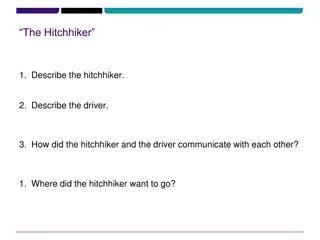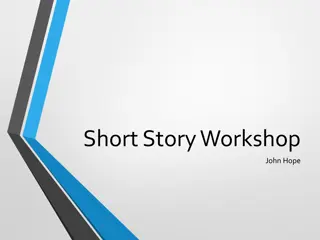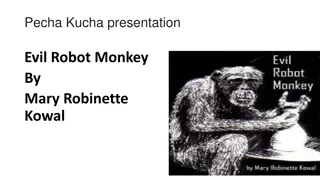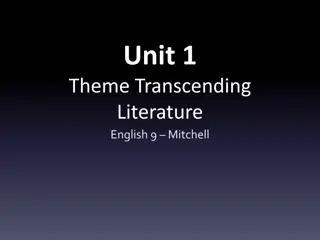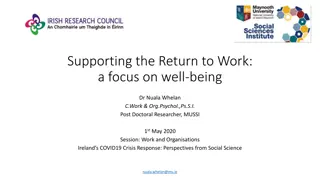Psychological Analysis of "The Hitchhiker" Short Story
Exploring the psychological aspects of the short story "The Hitchhiker" by Ara Son, this analysis delves into the characters' behaviors through the lenses of Id, Ego, and Superego. The driver's internal conflicts and decisions are dissected as he encounters a hitchhiker, leading to intriguing shifts in his psyche from Superego to Id. Through key events in the story – from stopping for the hitchhiker to the unexpected conclusion – the narrative unfolds the complexities of human nature and moral dilemmas.
Download Presentation

Please find below an Image/Link to download the presentation.
The content on the website is provided AS IS for your information and personal use only. It may not be sold, licensed, or shared on other websites without obtaining consent from the author. Download presentation by click this link. If you encounter any issues during the download, it is possible that the publisher has removed the file from their server.
E N D
Presentation Transcript
PSYCHOLOGICAL LENS IGNITE THE HITCHHIKER By: Ara Son
CHARACTER The Narrator / The Driver
BEGINNING THE DRIVER STOPS FOR HITCHHIKER I touched the brake and brought the car to a stop beside him. I always stopped for hitchhikers. I knew just how it used to feel to be standing on the side of a country road watching the cars go by, I hated the drivers for pretending they didn't see me, especially the ones in big cars with three empty seats. (Dahl 1) Id Wanting to ignore the hitchhiker because they can be dangerous Ego The driver debates whether he should give the hitchhiker a ride or not, but from his personal experience, he stops for the hitchhiker SuperEgo Let s the hitchhiker in and gives him a ride because it is nice to offer a ride.
MIDDLE THE HITCHHIKER TEMPTING THE DRIVER TO DRIVE FAST. "What can she do flat out?" he asked "One hundred and twenty- nine miles an hour," I told him. "I'll bet she won't do it." "I'll bet she will. (Dahl 2) Ego Wants to prove the hitchhiker wrong but does not want to break the law. But his wants exceeds his moral, so he ends up speeding Id Wants to see if the car can drive fast / wants to prove the hitchhiker wrong and wants to feel the sensation. SuperEgo It is against the law to speed, and it is dangerous
END HITCHHIKER STEALS THE POLICEMAN S NOTEBOOKS WITH THE DRIVER AND HITCHHIKER S INFORMATION In the long delicate fingers of his right hand, the man was holding up in triumph the two books he had taken from the policeman's pockets. (Dahl 7-8) Id Does not want to deal with the consequence / speeding ticket that was written in the policeman s notebook. Ego Happy that they do not have to deal with the speeding ticket anymore SuperEgo It is wrong and illegal to steal the police officer s stuff just to run away from the consequence one has made.
Beginning In the beginning the driver shows the characteristic of being superego, as he gives the hitchhiker a ride instead of ignoring him. ID, EGO, SUPEREGO CHARACTER S PROFILE Middle During the story, the driver often shows the characteristic of being Id. Instead of the driver following the law and doing what is safe, he is wanting to prove the hitchhiker wrong, so he ends up speeding. End At the end of the story the driver shows the characteristic of being Id, the driver is glad that he does not have to deal with the speeding ticket since the hitchhiker stole the policeman s notebook with all their information on it. Overall, the driver starts off by showing the characteristic of being superego in the beginning, but after he has met the hitchhiker, he often showed the side of being id.
CITATIONS Short Story Dahl , R. (1977). The Hitchhiker . Mr. Barrington's Blog . Retrieved October 18, 2021, from https://cpb-ca- c1.wpmucdn.com/myriverside.sd43.bc.ca/dist/b/55/files/2020/09/TheHitchhiker-by-Roald-Dahl.pdf Images VideoPlasty. (2018). File:Man Driving Car Cartoon Vector.svg . Wikimedia Commons . Retrieved October 18, 2021, from https://commons.wikimedia.org/wiki/File:Man_Driving_Car_Cartoon_Vector.svg Shaparenko , A. (n.d.). Dreamstime. Retrieved October 18, 2021, from https://www.dreamstime.com/autostop-creative-icon- simple-element-illustration-autostop-icon-symbol-design-travel-collection-can-be-used-web-mobile-image124364399 Makarenko , T. (2017). Cars Ahead on Road . Pexels . Retrieved October 18, 2021, from https://www.pexels.com/photo/cars- ahead-on-road-593172/ Kindel Media. (2021). Man in Gray Button Up Shirt and Black Pants Holding Car Door. Pexels . Retrieved October 18, 2021, from https://www.pexels.com/photo/man-in-gray-button-up-shirt-and-black-pants-holding-car-door-7715104/ McLeod, S. A. (2019, September 25). Id, ego and superego. Simply Psychology. https://www.simplypsychology.org/psyche.html










